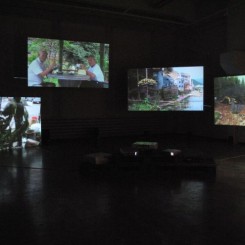Chen Hangfeng’s practice is one which never strays far from the issues affecting modern China. The “Logomania” series examines the branding of the urban landscape under the growing influence of materialism. Meanwhile, “Invasive Species” looks at contemporary attitudes towards migrants and seemingly “backward” practices of guerrilla gardening. “Santa’s Little Helpers” and “Scattered Scenes Along Mei Creek,” explore the impact of global manufacturing on the lives of the occupants of a farming village. All these works however, are linked by a central theme which ties which is the idea of adaptation—how we adjust to changing environments and the role tradition plays in the face of the juggernaut of modernity.
In light of his recent solo show at the Center for Chinese Contemporary Art, I chatted with Chen Hangfeng (please also see disclosure note at the bottom).
Daniel Szehin Ho: How did you come up with the idea of dealing with Christmas?
Chen Hangfeng: It started with the Christmas I spent in Canada, in 2005. Unlike what I experienced here in China—going out drinking, parties, and so on—it was so quiet in the countryside. This made me think about Christmas in a different way; it made me wonder.
So first I made a Christmas tree in 2006 with the Logomania series. Then I had a friend who told me the story with his grandparents who came from a village, near Rui’an in Zhejiang province [south of Shanghai], that makes a lot of Christmas ornaments.
He told me stories about the contrast between the quietness of the village and how everywhere there is this glittery stuff—green and red everywhere. He couldn’t really swim in the creek water, whereas before it had been home to lots of fish and shrimp. That’s how China is—the contrast between nature and what’s going on. They make so many different types of ornaments—with certain materials, like paper, plastic, Styrofoam, and glass.
I didn’t discover much in 2007 from my first two-day trip, when I focused on the shooting for “Santa’s Little Helpers”. But in my mind I wanted to go back. Then I did some more research about this village, which had such a long history—over 1000 years. They had a long tradition of scholarship, of participating in the Civil Service examinations, with the highest level reaching the Ministry of Rites in imperial times (礼部尚书)—which is kind of like the Cultural Bureau now (laughs).
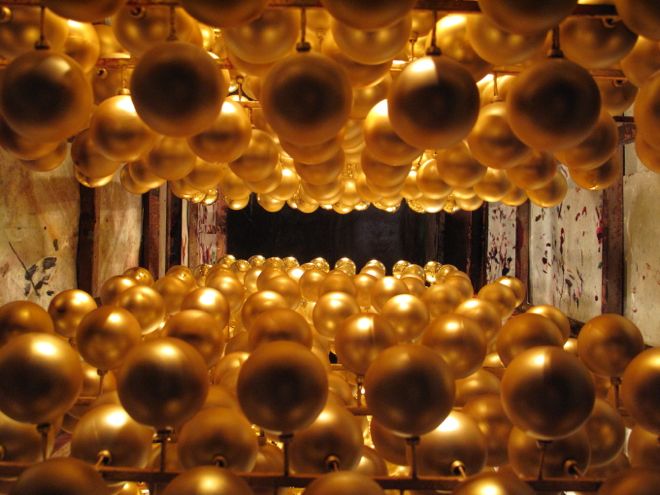
Chen Hangfeng, “Scattered Scenes Along Mei Creek,” video, HD, color, sound, 30’00’ 2012
陈航峰, 《梅源拾景》, 录像, 高清,彩色,有声音,30’00’, 2012
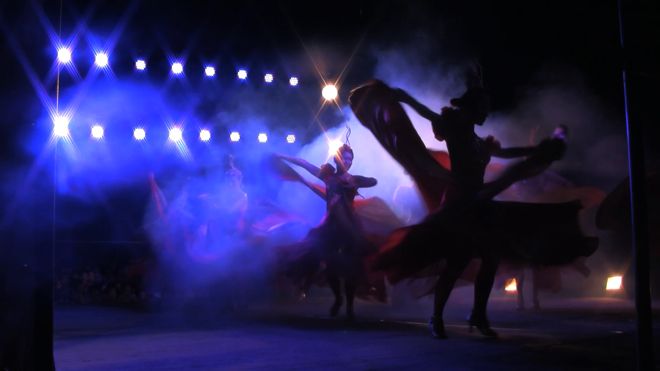
Chen Hangfeng, “Scattered Scenes Along Mei Creek,” video, HD, color, sound, 30’00’ 2012
陈航峰, 《梅源拾景》, 录像, 高清,彩色,有声音,30’00’, 2012
DSH: Then you went back again in 2012? What changed?
CHF: Yeah. Not so much changed—though the scale of production went down, since the economic downturn affected this village.
I also heard about this tragedy in a four- to five-storey building where the first two or three floors housed the family workshop, and the top floors were where the family lived. There was all this styro-foam and glue, and no one really knows what happened—but anyhow it caught fire, and only the two kids survived because they happened to be out somewhere in the middle of the night.
In 2012, I was trying to document more of their lives. Looking at the family genealogy, as well as the ancestral temple. This was a big change: back then it was derelict, but they renovated it. It’s actually now an activity center with mahjong, cards, Wenzhou-style lyrics (guci)—they played taped versions of it and very popular with the old people.
DSH: So you were looking into the village’s history?
CHF: I went through the family genealogy (zupu)—it’s a really a thick one, in big boxes; quite solemn and serious. I discovered a lot of scholars within the genealogy with pictures and stories—even one jinshi degree holder from the Kangxi period in the Qing dynasty [1661–1722].
So there is this poem I found by Sun Xidan (孙系旦) about the village. So I wanted as much as possible to have a traditional form to my practice. I was going over the poems…and then I looked at this village. I decided to use glue to write these poems, and sprinkle glitter on top.
DSH: I noticed that no one talks. Were you trying to avoid a documentary format?
CHF: I wanted to stay an outsider. Of course, I did talk to them a lot! But when I filmed them, I didn’t talk—maybe it’s because I still want to have a certain distance.
At the time, I was just focused on filming. I didn’t even bring a tripod, and especially didn’t want to disturb them too much. Plus there was also another issue: they couldn’t speak Mandarin, the older people.
This documentary aspect is a bit tricky. I thought a lot about this later. I chose to have four screens—I think it’s more interesting with multiple channels allowing for more of a feeling of micro-narratives—of the process of how they make these ornaments, the contrast, the glitter, and then the scenes of nature covered in garbage. Green leaves amid all these “glittering” objects; fish with glitter in the water, and so on.
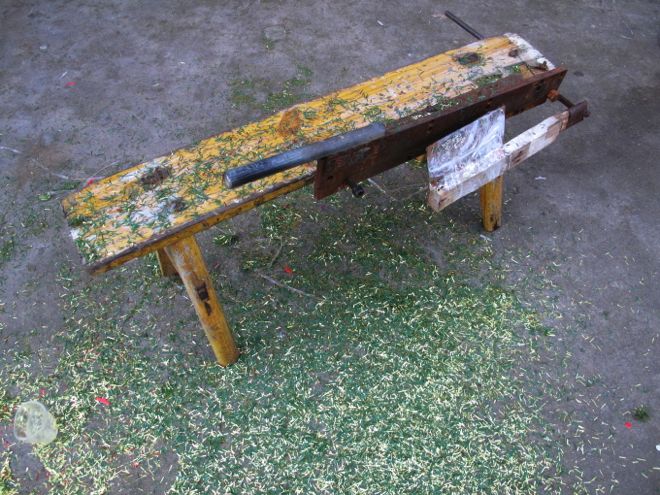
Chen Hangfeng, “Scattered Scenes Along Mei Creek,” video, HD, color, sound, 30’00’ 2012
陈航峰, 《梅源拾景》, 录像, 高清,彩色,有声音,30’00’, 2012
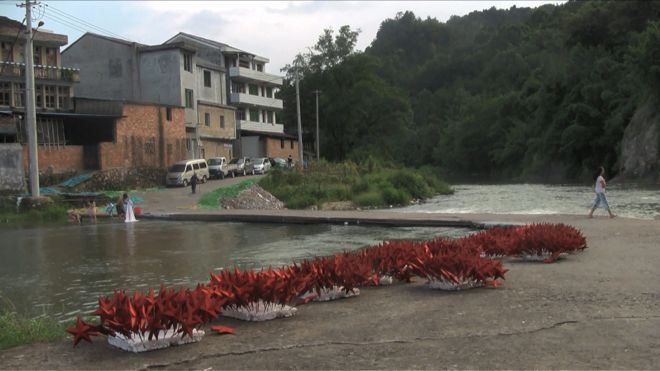
Chen Hangfeng, “Scattered Scenes Along Mei Creek,” video, HD, color, sound, 30’00’, 2012
陈航峰, 《梅源拾景》, 录像, 高清,彩色,有声音,30’00’, 2012
DSH: Why do they just throw the garbage away like that?
CHF: Maybe they just don’t have a high level of consciousness in regards to environmental issues. They try to control it, but these are family workshops—and they are careless.
What I found particularly interesting was the mentality: I found they were quite efficient—making ornaments in the same way they make food: bamboo sticks, with the baubles stuck on to them, painting them, and then just sticking them somewhere to dry—kind of like bingtan hulu [Chinese candied fruit]. And then there’s the adaption of farming tools. I still think: this is the wisdom of farmers.
DSH: What about the conditions in the workshop?
CHF: They work fast, but not fast like Chaplin fast. They’re quite relaxed—talking and so on. Everyday they have a quota to finish, as a part of the family business. But all the locals are the bosses, and they hire workers to work on them.
In fact, all this started with the production of painted bamboo blinds, and there was a Taiwanese who saw the demand for this product. Then the money came in. And then they adjusted to this. In the end, Christmas invaded their village.
The actual young people from this village were doing quite well. In a way, this village is quite rich.
There are young people working there, too, but they weren’t from the village; they were from much poorer places in Hunan.
DSH: How much do you as an artist think you should look at social issues?
CHF: I have always had an interest in the social—and some artists can be totally uninterested, which is fine. When we live in this environment, we are affected, and we are aware. Still, I think an art piece has to stand on its own.
DSH: With this piece, won’t audiences in the West just see exploitation under globalization?
CHF: Well, I hope people can go and watch the whole video. There’s much more than that…. The life there is quite peaceful. Yes, the landscape has changed—but you see how people adapt to it. I want people to think a bit more: after all, these are how those ornaments are made—and why do we need those things.
DSH: In fact, you went all the way to Finland last year, to Rovaniemi…
CFH: Yeah, I have this interview with the “Santa Claus” there. They have this Santa Claus village there, made for tourists—they even “moved” the Arctic Circle closer—this I found out later. They have this line which says “You are standing on the arctic circle,” but it’s not actually true—it’s make believe.
The whole set up is like Hollywood. Elves will ask you to wait, and “Santa” will try to guess where you are from. He has a room, desk, map of the world, DJ working the DJ table, taking videos and photos. You’re not allowed to take any pictures but everything was recorded on video.
I noted there’s this video I can buy, so the next day, I prepared a list of questions. Actually, they got very impatient—the elves asked me to go, but I kept asking him questions. What I asked were basically really dumb questions about Christmas and the Christmas industry.
Many Nordic villages claimed to be the home town of Santa Claus. This particular village is basically a shopping mall—with crap, probably all from China. It’s a theme park, not a village—and I chose a certain angle to make the footage surreal.
DSH: So you’ve looked at the production and consumption of Christmas…
CHF: Yeah, this export of Christmas is strange—it becomes just a product. The concept—well, here in China, Christmas has become overwhelming. Almost nobody here has any religious reasons [to celebrate it] and the power of consumption has taken hold to sell as much as they can. Quite hilarious, really.
I also think about the loss of identity: Why do we want to have this holiday? Chinese culture has so many festivals already. But again: they’re all being promoted as festivals of consumption.
DSH: So where else will you take this series?
CHF: I’m planning to go back to that village. I heard they are celebrating Christmas—they have so much leftover Christmas ornaments that the authorities said why don’t we just celebrate this [in order to use it up]? Meanwhile, international demand is going down—while domestic demand is rising.
In China, Christmas is just this consumption-fest. Couples go out, or get drunk or laid. It’s impossible to catch a cab, and then there’s that silly count-down on Christmas Eve. It’s like Christmas is turning into a whole different festival.
Actually, this Christmas topic isn’t just about Christmas. It’s about alienation, as well as about how something can jump from one culture to another, kind of like an “invasive species.”
“Scattered Sceneries Alongside Mei Creek” (8 mins clip) (Vimeo)
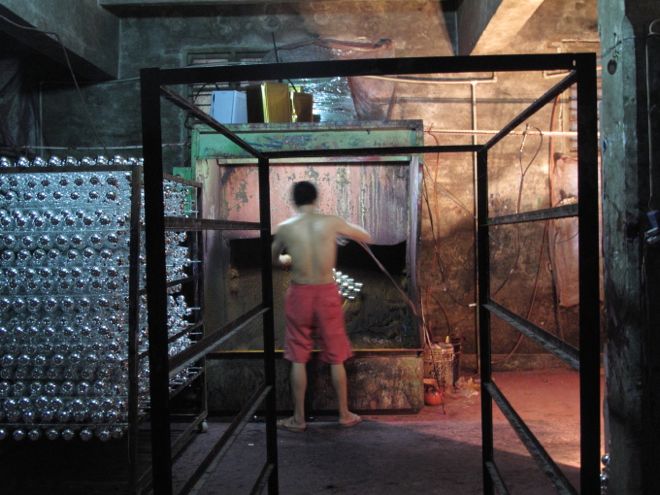
Chen Hangfeng, “Scattered Scenes Along Mei Creek,” video, HD, color, sound, 30’00’ 2012
陈航峰, 《梅源拾景》, 录像, 高清,彩色,有声音,30’00’, 2012
(Note: Chen Hangfeng is a frequent collaborator of OV Gallery. In accordance with randian’s ethics policy we must state that Rebecca Catching, a managing editor, is also the Director of OV Gallery.)

